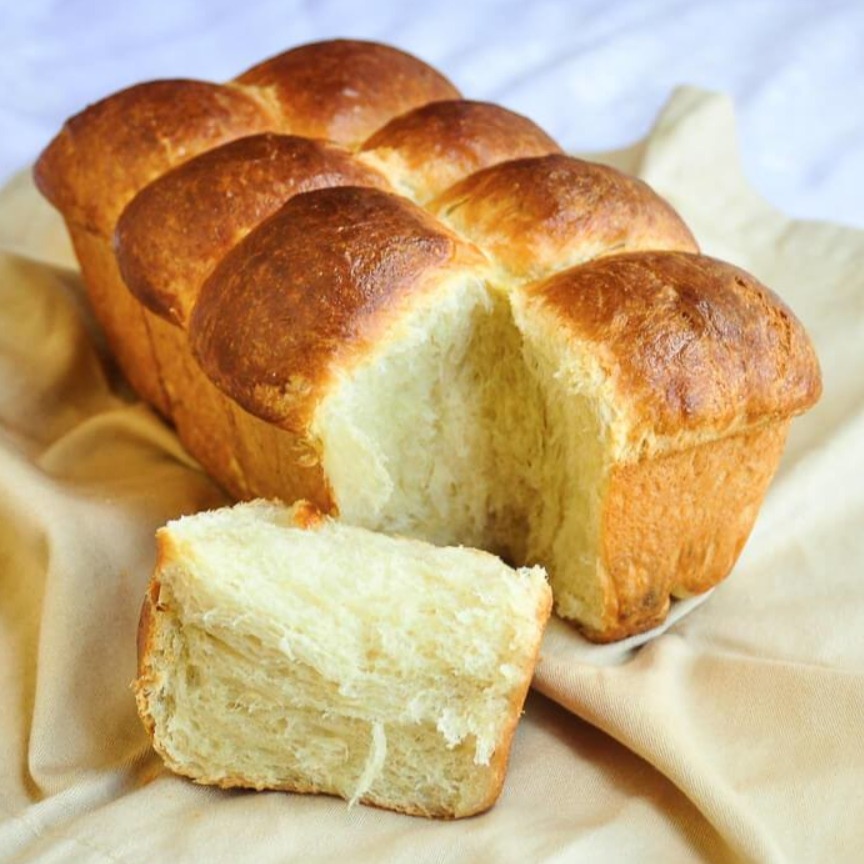Images Via Flickr
BAKING YOUR OWN BRIOCHE TAKES A LITTLE EFFORT BUT IT IS SO WORTH IT. LIGHT AND BUTTERY WITH A PILLOWY INTERIOR. THE LEFTOVERS ARE PERFECT FOR FRENCH TOAST
Brioche is a type of French bread made from a dough enriched with butter and eggs, giving it a tender, moist crumb and dark golden crust. Brioche comes in all shapes and sizes––dinner buns, hamburger buns, loaves, plain or with savory/sweet fillings.
Via Flickr
Homemade Brioche Bread is a yeast bread which requires a slow rise and an overnight cure in the refrigerator. It’s not a ton of hands-on time at all so don’t let the overnight rest deter you from making this heavenly loaf of bread.
And when you’re baking your French Brioche recipe the smell will reassure you that your work is going to pay off in a VERY big way. I thought my classic white bread was amazing but this brioche just squashed it…literally. It is off the charts amazing.
Via Flickr
Nutrition Info:
Calories: 220kcal | Carbohydrates: 26g | Protein: 5g | Fat: 11g | Saturated Fat: 6g | Cholesterol: 74mg | Sodium: 195mg | Potassium: 55mg | Fiber: 1g | Sugar: 3g | Vitamin A: 355IU | Calcium: 15mg | Iron: 1.6mg
PIN FOR LATER:
Ingredients:
6 eggs (at room temperature)
1 cup unsalted butter (2 sticks/½ pound/230g, at room temperature)
4 ¾ cups all-purpose flour (620g, divided)
Open Next Page for Full Recipe
Ingredients:
6 eggs (at room temperature)
1 cup unsalted butter (2 sticks/½ pound/230g, at room temperature)
4 ¾ cups all-purpose flour (620g, divided)
1 tablespoon active dry yeast (9g)
¼ cup granulated sugar (50g)
1½ teaspoons salt (8g)
½ cup warm water (120 ml, about 120 degrees F/49 degrees C)
2 teaspoons sugar (10g, dissolved in 1 tablespoon/15 ml water)
Instructions:
1st Day:
Take out 6 eggs and 1 cup / 230g butter a few hours before you begin to bring them to room temperature. Prepare all other ingredients before starting.
In the bowl of an electric mixer fitted with a paddle attachment, mix together 1 cup flour (130g), 1 tablespoon active dry yeast (9g), ¼ cup granulated sugar (50g), and 1½ teaspoons salt (8g), before adding ½ cup (120 ml) warm water (at about 120 degrees F/49 degrees C). Turn the mixer on a medium speed for a couple of minutes until well-combined.
Now add in 1 egg at a time. Only add the next egg when the previous egg is well incorporated.
Set the mixer to low. Add in 2 cups of flour (260g), a ¼ cup at a time, and let the mixer go until the dough is well combined.
Turn the mixer off, and cut the 2 sticks of softened butter into small cubes/chunks. With the mixer on medium, add the butter in 6 separate batches, waiting until the butter is well incorporated after each batch before adding more.
Set mixer to low. Now add in 1 3/4 cups of flour (230 grams), a ¼ cup at a time until the dough is well-combined. This dough will be very sticky (closer to a very thick batter) when it’s done.
Use a rubber spatula to clean the dough off the mixing paddle, and scrape the sides of the mixing bowl. Cover the dough with a plate or plastic wrap and let it proof at room temperature (about 70 degrees F/21 degrees C) for 3 hours, until it doubles in size.
After 3 hours have elapsed, punch and deflate the dough completely with a rubber spatula. Cover the dough with a plate again, and refrigerate it overnight until 3 hours before you’re ready to bake the next day.
2nd Day:
Remove the dough from the refrigerator. Divide it into two equal pieces. Shape them on a lightly floured clean surface, and place each into its own loaf pan. The chilled dough is a bit stiffer to work with, so you can use a rolling pin to help shape it into the desired width and length. If you do this, make sure to roll the dough lengthwise like a cigar when you’re done to ensure a rounded top to your loaf. Whatever you do, the dough should fit snugly in the loaf pan.
Now, you can create plain loaves as I’ve described above, or you could create a braid or individual buns, as pictured. Totally up to you, the baker!
Cover each loaf pan tightly with clear plastic wrap, and let proof at room temperature for about 2½ to 3 hours, until doubled in size.
Preheat the oven to 350 degrees F / 180 degrees C while the dough is proofing. Bake for 37 to 40 minutes in the center of the oven. Tent the loaves with foil if the crust is getting too dark. While it’s baking, prepare the sugar water by mixing 2 teaspoons sugar with 1 tablespoon water until the sugar is completely dissolved. When the bread is done, remove from the oven, and immediately brush the tops of the bread with sugar water to give it that shiny finish.
Let the bread sit in the loaf pan for 5 minutes to cool before transferring the loaves from the pans to a cooling rack. This cooling step is important so the bread does not fall apart.
Once the bread has cooled completely, you can store it in a tightly sealed container or zip-lock bag to keep it fresh. This bread is also heavenly when served slightly warm with softened butter.
From: Jacob Burton Youtube Channel
